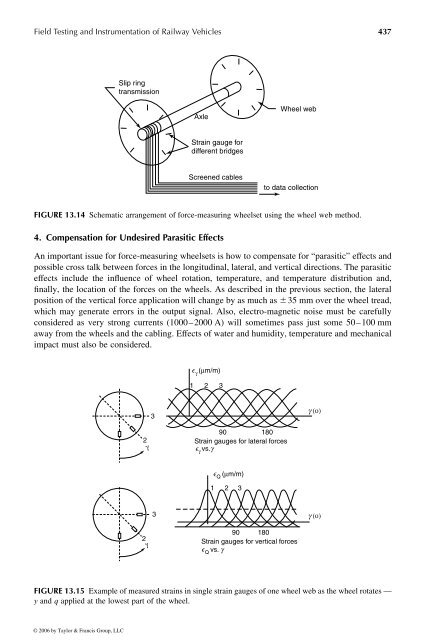You also want an ePaper? Increase the reach of your titles
YUMPU automatically turns print PDFs into web optimized ePapers that Google loves.
Field Testing and Instrumentation <strong>of</strong> <strong>Railway</strong> <strong>Vehicle</strong>s 437<br />
Slip ring<br />
transmission<br />
Axle<br />
Strain gauge for<br />
different bridges<br />
Screened cables<br />
4. Compensation for Undesired Parasitic Effects<br />
Wheel web<br />
to data collection<br />
FIGURE 13.14 Schematic arrangement <strong>of</strong> force-measuring wheelset using the wheel web method.<br />
An important issue for force-measuring wheelsets ishow to compensate for “parasitic” effects and<br />
possible cross talk between forces in the longitudinal, lateral, and vertical directions. The parasitic<br />
effects include the influence <strong>of</strong> wheel rotation, temperature, and temperature distribution and,<br />
finally, the location <strong>of</strong> the forces on the wheels. As described in the previous section, the lateral<br />
position <strong>of</strong> the vertical force application will change by as much as ^ 35 mm over the wheel tread,<br />
which may generate errors in the output signal. Also, electro-magnetic noise must be carefully<br />
considered as very strong currents (1000–2000 A) will sometimes pass just some 50–100 mm<br />
away from the wheels and the cabling. Effects <strong>of</strong> water and humidity, temperature and mechanical<br />
impact must also be considered.<br />
2<br />
γ<br />
2 γ<br />
3<br />
3<br />
γ ( μ m/m)<br />
1 2 3<br />
90<br />
180<br />
Strain gauges for lateral forces<br />
γ vs. g<br />
1<br />
Q ( μ m/m)<br />
2<br />
3<br />
90 180<br />
Strain gauges for vertical forces<br />
Q vs. g<br />
FIGURE 13.15 Example <strong>of</strong> measured strains in single strain gauges <strong>of</strong> one wheel web as the wheel rotates —<br />
y and q applied at the lowest part <strong>of</strong> the wheel.<br />
© 2006 by Taylor & Francis Group, LLC<br />
g (ο)<br />
g (ο)









